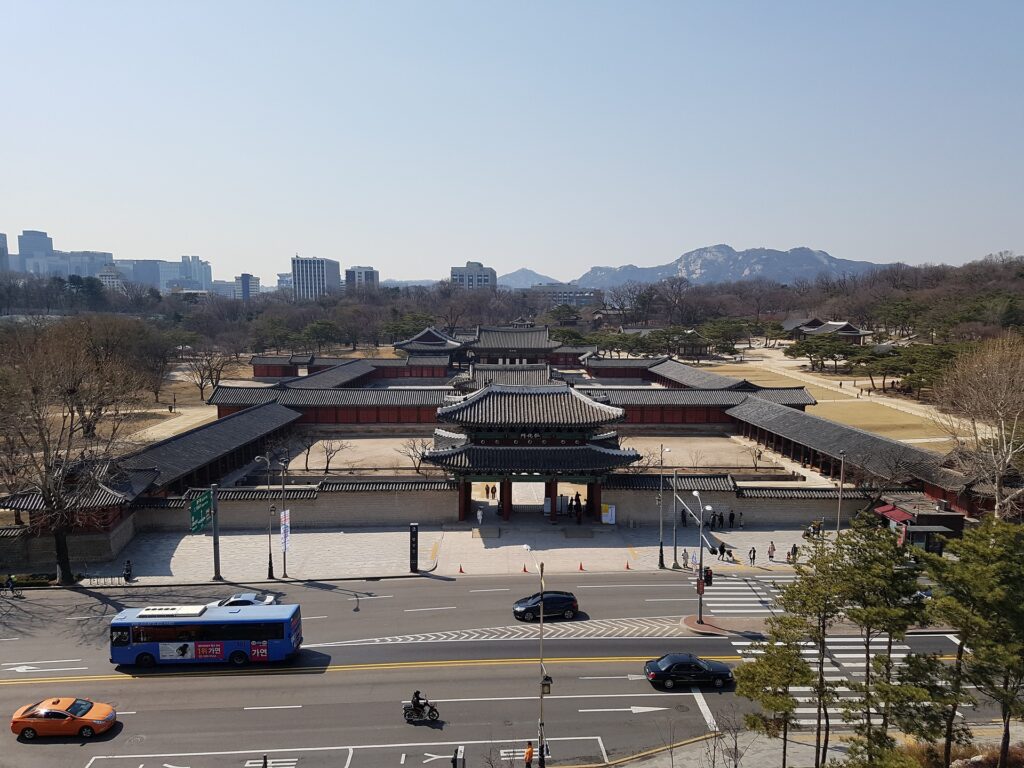Location: Jongno Gu District.
Open: Daily, 9am to 5:30pm (closed on Tuesdays).
Ticket Fee: Entrance fee is ₩13,000 (around $10 USD) for adults.
What is it? Gyeongbokgung Palace was the main royal palace of the Joseon Dynasty. The Dynasty was established in year 1395. Step back in time, get lost in the grand halls and courtyards of Gyeongbokgung. The palace stands over 600 years. Explore the National Folk Museum housed within the palace grounds. Showcasing Korean history and culture through artifacts and displays. The intricate roof decorations and colors of the palace buildings are examples of traditional Korean architecture. Witness the daily Changing of the Royal Guard Ceremony. A spectacle that brings the Joseon Dynasty back to life (check for specific times beforehand). Gyeongbokgung Palace was destroyed and rebuilt several times throughout its history. A testament to Korean resilience.
Why to go? Gyeongbokgung Palace is a must visit for anyone wanting to delve into Seoul’s history. Imagine you will be standing in the same halls as Korean royalty. Marveling at the architectural details, and witnessing the changing of the guard ceremony.
Location: Jongno Gu District.
What is it? Bukchon Hanok Village is a hidden gem in the heart of Seoul. The village is home to hundreds of traditional houses, called “Hanok”. Dating back to the Joseon dynasty. Stroll through a charming maze of hanoks nestled next to modern skyscrapers. All preserved with their tiled roofs and wooden beams. Explore cafes housed within these traditional structures. Sip on a cup of Korean tea, and soak up the atmosphere. You wanna know more about the history of Korea? Museums and cultural centers within the village offer a deeper dive into Korean traditions. There are more than 900 hanok homes in Bukchon Hanok Village. The five elements of the universe serve as the foundation for the hanok building philosophy. Earth, metal, fire, wood, and water. So, the building materials that used were wood, clay, paper, stone, and metal. Hanok aims to create an environment in which people and the natural world can live together. By making it possible for them to coexist. Bukchon is a popular choice for celebrity residents. The village’s beauty and peaceful ambiance are the reason behind that.
Why to go? Escape the city noise, wandering through alleyways, and experiencing traditional Korean architecture firsthand. Hanoks. Bukchon is a perfect place for photographers, history lovers, and anyone seeking a slice of culture in the heart of the city.
Location: Namsan Mountain in the Yongsan Qu District.
Open: Daily, 10am to 11pm (last admission at 10:30 PM).
Ticket Fee: Entrance fee for the observatory deck is ₩13,000 (around $10 USD) for adults.
What is it? N Seoul Tower (Namsan Tower) is the highest point in Seoul. The observatory deck gives you a 360 degree view of the entire city. Perfect for stunning photos and seeing the urban landscape. Reach the top by a cable car, enjoy the ride, or take the elevator for a speedy ascent. Love locks adorn the fences around the tower. Adding a romantic touch and symbolizing eternal love (bring your own lock if you’re feeling sentimental!). The tower changes color for special occasions and holidays, adding a festive touch to the Seoul skyline. Namsan Tower was also the first general radio wave tower in South Korea. Broadcasting signals for media outlets such as SBS, MBC, KBS, and FM.
Why to go? N Seoul Tower is a must visit for anyone seeking a bird’s eye view of Seoul’s energy. Stand above the city lights, snap panoramic photos, and see the metropolis. N Seoul Tower offers a chance to experience Seoul from a upper new angle.
What is it? The Han River, a ribbon of 514km blue flowing through Seoul. Giving you a welcome break from the city. Enjoy a bike ride or a walk along the riverbank pathways. Breathe in the fresh air and see the views of the cityscape. Hop on a boat cruise for a journey down Han River. Allowing you a new angle on Seoul’s famous sites. During the summer months, the riverside comes alive with festivals, concerts, and outdoor activities. Locals often head to the Han River to unwind. Han River is crossed by 27 bridges. Each having a unique architectural designs and historical significance.
Why to go? In the center of Seoul, the Han River creates a peaceful haven. The Han River is the ideal location to unwind, refuel and discover a new aspect of Seoul. Picture yourself leaving the concrete jungle behind. Relax by the water, and engage in outdoor sports.
Location: Jongno Gu District.
Open: Daily, 9am to 6pm (Temple grounds close at 5:30pm).
What is it? Jogyesa Temple is one of the most important Buddhist temples in Korea. Standing as symbol of Korean Buddhism. Located in the city near Insadong. The Temple was first built in 1395. Afterwards been rebuilt several times and moved once in the past. Since 1936, it has been the head temple of the first district of the Jogye Order of Korea Buddhism. Daeungjeon (Main Dharma Hall) is the center of Jogyesa Temple. One of the first thing you will notice are the golden statues of Amitabha Buddha, Shakyamuni Buddha, and Bhaisaiya Buddha. These golden statues measure over 4.8m. Participate in a temple stay program (reservations required). Here you gain a deeper understanding of Buddhist practices and experience temple life firsthand. The temple hosts cultural events throughout the year. Traditional tea ceremonies or Buddhist art exhibitions.
Why to go? Anybody looking for a quiet moment to themselves in Seoul should make a trip to Jogyesa Temple. Jogyesa Temple delivers a place for inner serenity. You will be seeing Buddhist rites, and discovering a unique aspect of Korean culture.
Location: Ihwa Dong Neighborhood of the Yongsan Gu District.
What is it? Ihwa Mural Village is an surprising attraction in an unexpected setting. Ten years ago, the neighborhood was scheduled for destruction in order to make room for new construction by removing what was seen as an aging and ugly area of Seoul. Yet in 2006, the Ministry of Culture, Sports, and Tourism’s Art in the City, Naksan Cultural Project, turned the neighborhood into a tourist destination. Highlighting metal sculptures, mural paintings, and mosaics created by regional artists on the walls and stairwells. Most of the murals are interactive, encouraging viewers to snap pictures and be part of the art. An constantly developing and dynamic outdoor show is created. New masterpieces are discovered around every corner. Local shops and cafes nestled within the village offer drinks and souvenirs, adding to the unique experience.
Why to go? Ihwa Mural Village is an absolute must do for anyone seeking an artistic experience in Seoul! Just imagine for a moment how incredible it would be to snap photos with colourful murals, and yourself being part of it. Ihwa Mural Village a testament to the power of art!
Location: Jongno Gu District.
What is it? Welcome to Naksan Park enjoy the golden hour that paints the evening sky in Seoul! View the panoramic view of downtown as a work of art. Naksan Park is an green space where you can walk along the Seoul City Wall. Hike up the trails, enjoying the fresh air and the changing scenery. N Seoul Tower, perched atop the mountain, offers even more spectacular views. Several historical sites and temples are scattered throughout the park. Serving as view into Seoul’s rich heritage. Naksan Park was once a royal hunting ground during the Joseon Dynasty. Nowadays home to diverse wildlife, see birds, squirrels, and even the occasional fox.
Why to go? Naksan Park will give you a hike, leave the noise of the traffic, to take in stunning cityscapes. Naksan Park creates an opportunity to get back in touch with nature. See Seoul’s beauty from a new angle.
Location: Mapo Gu District.
Open: Many restaurants and bars are open late, some until dawn.
Ticket Fee: Some venues have cover charges for special events or live music.
What is it? Getting swept away by the energy of a city that never sleeps. Hongdae, a youthful district with universities and art schools. Is the heart of Seoul’s nightlife. Lined with trendy bars, live music venues, and quirky pubs. Hongdae is waiting for your night out. Belt out your favorite K-Pop tunes at a karaoke bar. Hongdae is known for its independent music scene and artistic flair. See talented musicians performing live, or simply grab a drink and have a good conversation. The district is a popular spot for people watching and experiencing the youthful energy of Seoul. Street food stalls tempt your taste buds with delicious late night snacks, and the energy is infectious.
Why to go? Hongdae nightlife is a chance for an exciting night experience in Seoul. Dance the night away, discovering hidden bars in alleyways. Soaking up the youthful energy. Hongdae offers a chance to let loose, and experience a different side of Seoul after dark.
Location: Jongno Gu District.
Open: Daily, 9am to 5:30pm (closed on Mondays).
Ticket Fee: Entrance fee is ₩10,000 (around $8 USD) for adults.
What is it? Changdeokgung Palace was built as a secondary palace in Seoul. Next to Gyeongbokgung Palace (primary palace), in 1405. In the following year, the Secret Garden was formed on the north of Changdeokgung. Get yourself transported to a past era. Discover the grand halls and courtyards of Changdeokgung Palace. For over 250 years this UNESCO World Heritage Site was the main palace for the Joseon Dynasty! Marvel at the details of the throne rooms and learn about the lives of Korean royalty. Explore the Secret Garden (reservations required). The Garden was designed to emulate the natural beauty of Korean landscapes and served as a place for royal relaxation. The landscape has ponds, pavilions, and hidden walkways. Changdeokgung Palace is known for its architectural style. Incorporating both Korean and Chinese influences.
Why to go? Going to Changdeokgung Palace is essential for everyone interested in learning more about the history of Seoul. Between its architecture, Secret Garden, and opportunity to stroll in the footsteps of royalty. Changdeokgung Palace serves an introduction to Korean history as well as a window into a former period.
Location: All over Seoul!
Open: Many restaurants and street food stalls are open late.
Ticket Fee: Most restaurants have menus with listed prices.
What is it? Lets talk about food! Seoul is a foodie paradise. No Seoul adventure is complete without trying kimchi. Korea’s national fermented dish made with cabbage and spices. However kimchi is just the tip of the iceberg! Savor BBQ meats, slurp down bowls of bibimbap, and tantalize your taste buds with spicy stews. Korean meals are typically served family style, with several dishes shared amongst everyone at the table. Try everything from traditional street food delights to Michelin starred fine dining. Many restaurants offer free side dishes called “Banchan”. Which are a fantastic way to try different Korean flavors. Kimchi is super healthy and has many benefits. Such as supplying good bacteria that can improve gut health.
Why to go? Seoul is a dream for any adventurous eater. Explore food markets, try street food from, and indulge in delicious Korean classics. Seoul offers a culinary adventure for every day of the week.



















